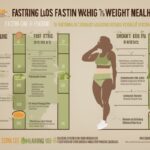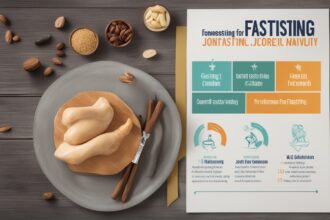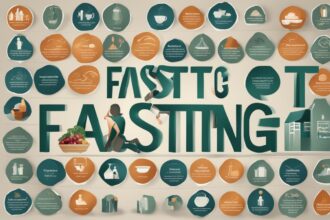Fasting has long been recognized for its potential health benefits, from weight loss to improved metabolic health. However, one area gaining attention is its impact on joint health. Specifically, intermittent fasting (IF) has emerged as a promising approach for alleviating joint pain and inflammation. In this comprehensive guide, we’ll explore Intermittent Fasting Joint Relief Strategies and how they can support healthier joints. Whether you’re dealing with arthritis, stiffness, or general joint discomfort, these strategies may offer a natural way to find relief.
What Is Intermittent Fasting and How Does It Relate to Joint Health?
Intermittent fasting is an eating pattern that alternates between periods of eating and fasting. Popular methods include the 16/8 method (fasting for 16 hours and eating within an 8-hour window) and the 5:2 diet (eating normally for 5 days and restricting calories on 2 days). While often associated with weight loss, IF also influences systemic inflammation—a key factor in joint pain and conditions like osteoarthritis and rheumatoid arthritis.
During fasting, the body enters a state of ketosis, where it burns fat for energy. This process can reduce inflammatory markers in the body, potentially easing joint pain. Additionally, fasting promotes autophagy, a cellular repair mechanism that may help remove damaged tissues around joints. By incorporating intermittent fasting joint relief strategies, individuals may experience reduced swelling and improved mobility over time.
The Science Behind Intermittent Fasting and Joint Pain Reduction
Research suggests that intermittent fasting can lower levels of pro-inflammatory cytokines, which are proteins that contribute to inflammation in the body. A study published in the journal Cell found that fasting triggers a metabolic switch that reduces inflammation and oxidative stress—both of which are linked to joint degradation. By adopting intermittent fasting joint relief strategies, you may help your body combat these harmful processes naturally.
Moreover, IF can aid in weight management. Excess body weight places additional stress on joints, particularly in the knees and hips. Losing weight through fasting can directly alleviate this pressure, resulting in less pain and better joint function. For more on how weight impacts joint health, check out our post on Weight Loss and Joint Health Benefits.
Top Intermittent Fasting Joint Relief Strategies to Try
If you’re new to intermittent fasting or looking to optimize it for joint health, here are some practical strategies to consider:
- Start with a Beginner-Friendly Schedule: Begin with the 12/12 method (12 hours of fasting, 12 hours of eating) to ease your body into the process. Gradually progress to 16/8 as you become more comfortable.
- Stay Hydrated: Dehydration can worsen joint pain. Drink plenty of water during fasting periods to keep your joints lubricated and reduce stiffness.
- Incorporate Anti-Inflammatory Foods: During eating windows, focus on foods rich in omega-3 fatty acids (like salmon), antioxidants (like berries), and turmeric to further support joint health.
- Avoid Overeating: Bingeing after a fast can spike inflammation. Stick to balanced meals to maintain the anti-inflammatory benefits of fasting.
These intermittent fasting joint relief strategies can be tailored to your lifestyle. For additional tips on anti-inflammatory diets, read our guide on Anti-Inflammatory Foods for Joint Pain.
Combining Intermittent Fasting with Other Joint Health Practices
While intermittent fasting offers significant benefits, combining it with other joint health practices can amplify results. Low-impact exercises like yoga or swimming during non-fasting periods can improve joint flexibility without causing strain. Additionally, consider incorporating supplements like glucosamine or collagen, which support cartilage health, after consulting with a healthcare provider.
Another effective approach is to pair IF with stress management techniques such as meditation. Chronic stress can exacerbate inflammation, so reducing stress levels can enhance the effectiveness of intermittent fasting joint relief strategies. Learn more about stress and joint health in our article on Stress, Inflammation, and Joint Pain.
Potential Risks and Precautions for Intermittent Fasting
While intermittent fasting can be beneficial, it’s not suitable for everyone. Individuals with certain medical conditions, such as diabetes or eating disorders, should consult a doctor before starting IF. Additionally, fasting may initially cause fatigue or irritability, which could affect your ability to stay active—a key component of joint health. Listen to your body and adjust your fasting schedule as needed.
Pregnant or breastfeeding individuals and those on specific medications should also avoid fasting without medical guidance. For a deeper dive into who should avoid fasting, explore our post on Fasting Safety Guidelines.
Real-Life Success Stories and Tips for Long-Term Success
Many individuals have reported positive outcomes from using intermittent fasting joint relief strategies. For instance, Jane, a 45-year-old with mild osteoarthritis, found that adopting a 16/8 fasting schedule reduced her knee pain within two months. She paired fasting with a diet rich in anti-inflammatory foods and gentle stretching, noting significant improvements in her daily comfort.
For long-term success, consistency is key. Set realistic goals, track your progress, and don’t hesitate to adjust your fasting windows if needed. Joining a community or reading success stories can also provide motivation. Check out our collection of inspiring stories at Fasting Success Stories.
Disclaimer: The information provided in this article is for educational purposes only and should not be considered medical advice. Intermittent fasting may not be suitable for everyone, and results can vary. Always consult with a healthcare professional before starting any new dietary or fasting regimen, especially if you have pre-existing health conditions or are taking medications. We are not responsible for any adverse effects resulting from the application of the strategies discussed in this post.
References
- de Cabo, R., & Mattson, M. P. (2019). Effects of Intermittent Fasting on Health, Aging, and Disease. Cell.
- Arthritis Foundation. (n.d.). Weight Loss and Arthritis.
- Longo, V. D., & Mattson, M. P. (2014). Fasting: Molecular Mechanisms and Clinical Applications. NCBI.
- Mayo Clinic. (n.d.). Fasting: What You Need to Know.
- Harvard Health Publishing. (2018). Intermittent Fasting: Surprising Update.
This content is for informational purposes only and not a substitute for professional advice.






